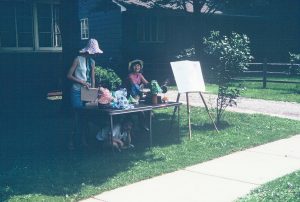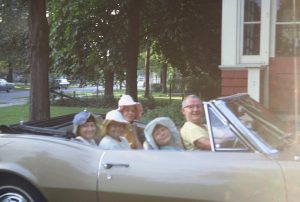

I don’t know which one of us found the pattern first, me or my best friend Barb. It was probably her – her Mom was a Home Ec. Teacher and an excellent sewer. The pattern was easy: cut out twelve identical “petals,” sew six together to form two round flower shapes, and then sew the two halves together, inverted, to make a reversible floppy hat shaped vaguely like a tulip. Don’t laugh. It was the 60s.
We were about 15, free for the summer, and restless. Our parents didn’t want us to get summer jobs until we were older, but we wanted money. We had read (we were into competitive reading that year) Cornelia Otis Skinner’s Our Hearts Were Young and Gay, her memoir of being a teenager in the 1930s, going with her best friend on a voyage to Europe. Shipboard, of course. The book is very funny. We had decided that we were going to do this (not recognizing that young Cornelia was sponsored by parents who were considerably better off than our own). It being the 60s, the idea of backpacking through Europe was in the air. When we finished high school, we would bicycle and backpack through Europe, seeing all the historical sights and seeking adventure.
This is where the Tulip Hats come in. We decided to spend the summer sewing these hats and selling them to our friends, neighbors, and anyone else we could persuade to buy them. Each of our mothers had a sewing machine, and the pattern was simple enough that we could create an assembly line method for the project. Our first fabric came from scraps our mothers had; when that ran out, we looked through the cotton remnants at local fabric stores. Remember fabric stores?
We wore out that first tissue-thin pattern pretty quickly, so we traced the petal shape on shirt cardboards and cut out sturdier ones. We made flowered hats with plain colored linings, flowered hats with flowered linings, plaid hats with whatever linings we could devise, and on and on. We wrangled our mothers and all our sisters, female cousins, and grandmothers to buy them. The cost: $1.00. We had a booth on the street for a while; we went to relatives’ businesses and sold them (I remember going to the offices of Your Host restaurants, where my grandmother kept the books, and beguiling all the “office ladies” into buying hats.)
We set up our workshop in the front porch of our house, a place airy with big windows, cool from the shade of two large chestnut trees, and out of the way of our families, who decided we had gone crazy. We bought a little cash box at the 5 and Dime (remember 5 & Dime stores?) and kept our proceeds in it. We had the transistor radio I had made from a Heathkit for background music: “Hot town, summer in the city/ Back of my neck getting dirty gritty” was a hit. So were the songs “Windy,” “Can’t Take My Eyes Off of You,” and “Light My Fire.” By that you know it was 1967.
Every so often my father would pop his head through the front porch door and ask, “How’s the sweatshop going?” We had a great time, bopping along to the music. We pumped most of our earnings back into buying more fabric for more hats. We made about 15 or 20 cents on each hat, if that. And then, we ran out of people to sell hats to, just as summer was waning and 10th grade was approaching. We made about $12.00 in all – not quite enough to get us to Europe together, but the dream didn’t die. I went on an exchange program in college, and a few years later Barb, as a History teacher, got her wish.

